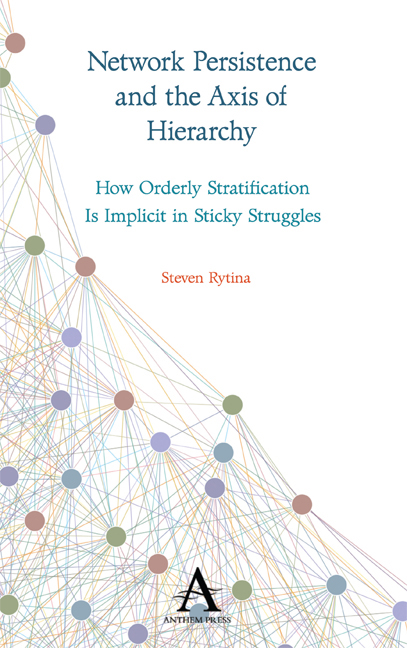 Network Persistence and the Axis of Hierarchy
Network Persistence and the Axis of Hierarchy Book contents
- Frontmatter
- Contents
- List of Illustrations
- Preface
- Chapter One Sticky Struggles: The Unified Pattern of Social Ranks Inherent in Networks
- Chapter Two Foundations of Cacophony
- Chapter Three Knots of Regularity
- Chapter Four Hierarchy: Inevitable but Inevitably Messy
- Chapter Five The Inevitable Emergence of Stratification
- Chapter Six Scaling Intergenerational Continuity: Is Occupational Inheritance Ascriptive After All?
- Chapter Seven Taming the Mobility Table
- Chapter Eight Is Occupational Mobility Declining in the United States?
- Chapter Nine The Continuum of Class over Time: Deconstructing Imposed Class to Uncover Empirical Classes
- Chapter Ten Concluding Reflections
- Appendix Why Robust Attraction Is (Effectively) Inevitable for Mobility Data
- Index
Appendix - Why Robust Attraction Is (Effectively) Inevitable for Mobility Data
Published online by Cambridge University Press: 30 April 2020
- Frontmatter
- Contents
- List of Illustrations
- Preface
- Chapter One Sticky Struggles: The Unified Pattern of Social Ranks Inherent in Networks
- Chapter Two Foundations of Cacophony
- Chapter Three Knots of Regularity
- Chapter Four Hierarchy: Inevitable but Inevitably Messy
- Chapter Five The Inevitable Emergence of Stratification
- Chapter Six Scaling Intergenerational Continuity: Is Occupational Inheritance Ascriptive After All?
- Chapter Seven Taming the Mobility Table
- Chapter Eight Is Occupational Mobility Declining in the United States?
- Chapter Nine The Continuum of Class over Time: Deconstructing Imposed Class to Uncover Empirical Classes
- Chapter Ten Concluding Reflections
- Appendix Why Robust Attraction Is (Effectively) Inevitable for Mobility Data
- Index
Summary
Robust attraction refers to how the principal dimension anticipates averages over mobility counterparts no matter what scale is used to evaluate the elements in mobility counterparts. This appendix surveys the basis for this regularity.
The argument that follows has very wide application. One of the most telling illustrations would be a census of transitions collected into a matrix. On this interpretation, the argument advanced here applies to any population with a history that is meaningful in such terms. An obvious limiting condition is the nonoccurrence of massive instability that renders social continuity negligible. For convenience I will refer to the matrix of transitions using the terms and conventions of mobility tabulations, but the scope of the argument is historical and not limited to samples.
The review comprises nine sections. First, notation is provided for scales and mobility data that facilitates mean- centering. Second, the algorithm for symmetric scaling of intergenerational continuity (SSIC) is derived by setting the gradient of the log of the correlation to zero. Third, focus is shifted to a closely related symmetrical variant on the correlation also maximized by solving for a gradient equal to zero. Fourth, the solution is shown to be the eigensolution with the greatest eigenvalue. This supplies a new, rich characterization of the limit of iterated averaging. Fifth, NT- weights (weighting by sums of rows and columns) are shown to lead to an orthonormal basis. Sixth, the orthonormal basis provides an elegant decomposition for arbitrary occupational scales. Seventh, a general formula for covariance of arbitrary numbers of iterations of averages (over mobility counterparts) is derived. Eighth, convergence to the principal dimension, that is, robust attraction, is shown to be inevitable. Ninth, “higher” dimensions (those beyond the principal dimension) are shown to be negligible noise in each of the three principle data sets used in this study.
Notation for Mobility Tables and Marginal Scales
Designate a mobility table of frequencies as T. T is a K × K square matrix of counts with entries Ti,j and K rows and columns. By convention, rows correspond to fathers (or “pas”) and columns to offspring, with totals NPi and NOj.
- Type
- Chapter
- Information
- Network Persistence and the Axis of HierarchyHow Orderly Stratification Is Implicit in Sticky Struggles, pp. 335 - 348Publisher: Anthem PressPrint publication year: 2020


